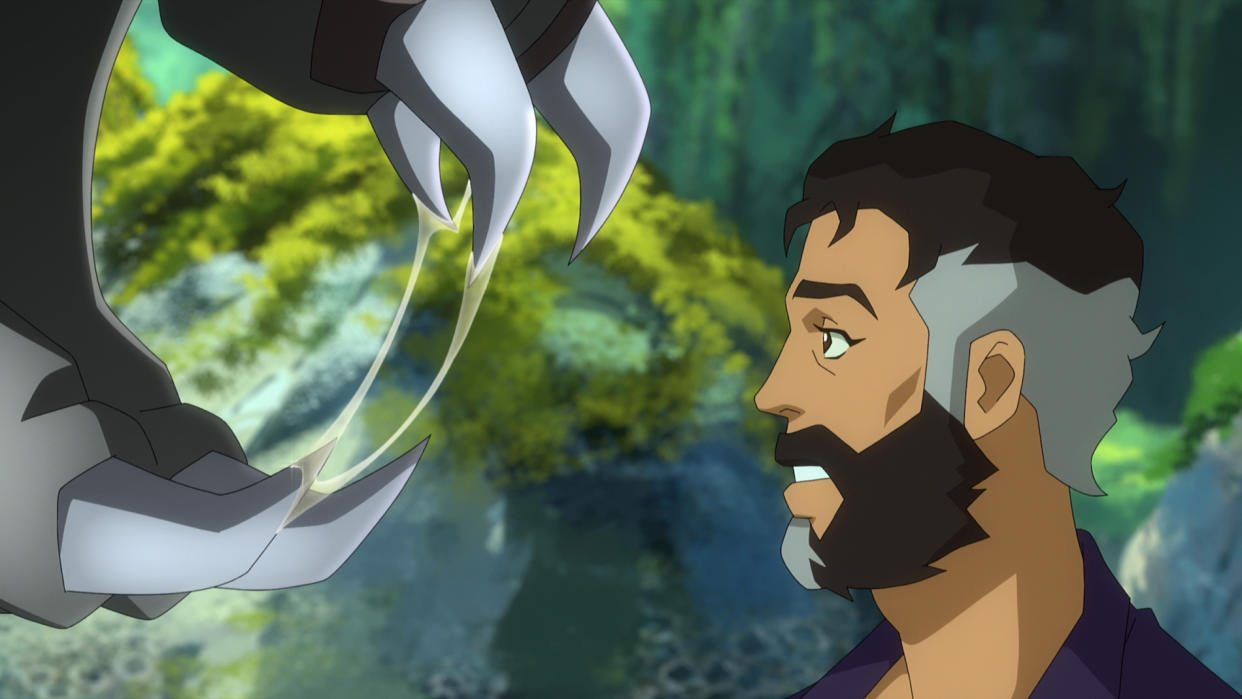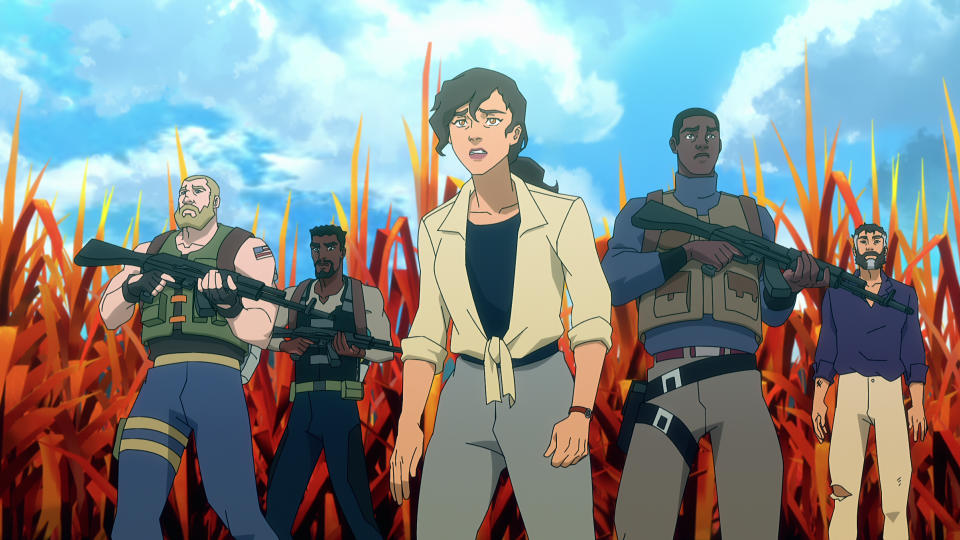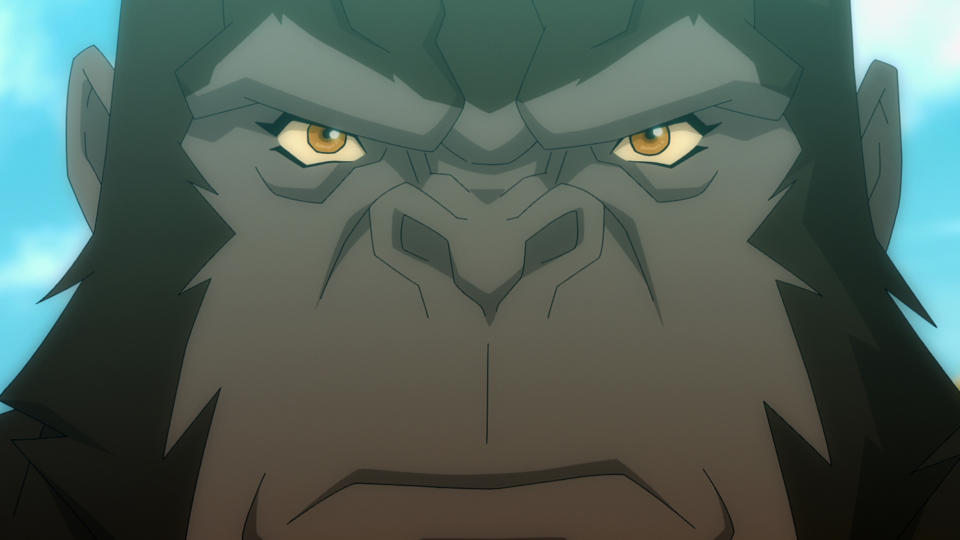Netflix Kong Show ‘Skull Island’ Is Franchise TV with a Twist

A show like “Skull Island” usually gets bogged down by demands and expectations. The new animated Netflix series isn’t about King Kong, but the big fella definitely makes his presence known.
Given that this eight-episode season exists within a broader umbrella that also encompasses kaiju of all kinds, you’d expect that series creator and showrunner Brian Duffield would have to wade through an ocean of demands and limitations. Instead, writing “Skull Island” became a chance to focus on a new batch of explorers (voiced by an ensemble including Benjamin Bratt, Betty Gilpin, Mae Whitman, and Nicholas Cantu) who find themselves on Kong’s home island and discover otherworldly creatures dotting its beaches and forests.
More from IndieWire
Duffield said that his experience on “Skull Island” wasn’t hampered by the usual meddling and franchise maintenance preciousness that we’ve come to associate with high-profile shows that have become brand extensions, regardless of what medium they’re presented. The biggest “Skull Island” sticking point was the name of the boat (that would eventually come to be called “Once Upon a Maritime”).
“I had it as the Venture, the classic Kong ship. Legendary sent a screengrab of the ‘Skull Island’ movie. In the background, there’s a boat that says ‘Venture’ on it. And they’re like, ‘So we’ve already used it,'” Duffield said. “Partially because I was annoyed, I was trying to think, ‘What’s like the most obnoxious name I could come up with for the boat?’ But it fit in with Hiro’s vibe. It’s very romantic. Once I thought of the pun, I kind of cringed and I was like, ‘Oh my God, that would be what they would name it.'”
Without many of the usual franchise tethers of setting up in-universe developments, “Skull Island” is the final product of a certain amount of freedom to make an adventure show where King Kong happens to pop up, rather than being the sole reason for the show to exist. (Although sometimes veering in the exact opposite direction can sometimes work too). For “Skull Island,” it’s not just that there’s an emphasis on making relatable human characters, but the show also gives them some key emotional shades that Kong-adjacent explorers haven’t really had in the past. Where past Skull Island thrill-seekers are coded as unstable or untrustworthy, this new group finds some genuine audience-aligned fun amidst the peril.
“The Cap character is so excited. Even when his life’s in danger, there’s a real joy and wish fulfillment to that for him. Bratt and I talked about that. I told him, ‘You’re a good guy. You’re worried about your son. And you would prefer not to die yourself. But beyond that, you are fucking stoked,'” Duffield said. “Annie thinks it’s great, the whole time, that her life is in danger. Then, once Dog and the boys are involved, for me, the hope was that it takes the tension away from ‘Will they get eaten?’ and more into, ‘How are they going to get out of this problem using their very different personalities?'”

Watching “Skull Island,” there’s definitely some throwback DNA here. Going beyond the usual making-something-for-all-ages goal, Duffield mentioned that he wanted the show to fit in with the weekend morning, bowl of cereal feel that other extended universe animated series have had across different eras. In doing that, he found that Skull Island the place is a hotbed for violence, but “Skull Island” had to be careful about who that violence was directed at. It’s a lesson he carried over from “Spontaneous,” his feature directorial debut from 2020.
“People are very sensitive about whose blood they see. If it’s a merc, people have no problem seeing some some bones break. If it’s a character that an audience would deem a likable character, they can get really turned off and really sensitive to that,” Duffield said. “There was a couple times with Powerhouse [Animation Studios] where I would see the storyboards and say, ‘OK, that character can’t have blood. This guy? Go nuts.’ The goal for the show was always to live in that PG-13, ‘Jurassic Park’ space. But again, there’s a big difference between the lawyer on the toilet getting bitten and if Lex got bitten.”
One critical part of getting audiences to care about these characters is the casting. Duffield said that it wasn’t a necessity for the project going in, but that you could keep the cast as is and it would still work in a live-action version. Among the individual praise: Nicholas Cantu, who stars as the younger Charlie, trying to balance his future with potential adventures with his father (“He gets a lot of the season where he’s by himself and has to basically narrate what’s going on in a way that’s not annoying. He’s like a wind up toy. He just goes and you’re like, ‘This is great,'” Duffield said); Gilpin as Irene, another of the Skull Island ground team brought together by a storm (“I’m obsessed with some of Betty’s line deliveries in ‘The Hunt’ and ‘Mrs. Davis.’ She’s the perfect actress.”); Mae Whitman as Annie, the lone human on the island who’s managed to acquaint herself with the surroundings (“I’ve been such a huge fan of hers for forever. I remember going to the live reads that Jason Reitman used to do at LACMA and she was always the secret weapon there. I love her ability to be such a Tasmanian devil, and then make you cry on a dime.”); and voice acting legend Phil LaMarr as fellow explorer Sam (“As I was writing it, I kept adding more for that character to do. When he came up as an option, I was like, ‘Of course.'”).
Those performers, in turn, help to handle some of the ways that “Skull Island” Kong itself is an inescapable piece. (Duffield acknowledged that the animated Kong is a little smaller than his blockbuster tentpole counterparts, but only because keeping at the Legendary movies’ scale meant that all the explorers would be able to see him as soon as they landed on shore.) But one of the shrewdest moves of this new series is not to get bogged down in overly long treatises on the current state of Monsterverse lore. (Duffield’s one-man Twitter AMA sessions both leading up to and after the show’s release still demonstrate his love and attention for those details, even if “Skull Island” itself doesn’t always stop everything to point them out.) For those franchise-texture bits the show does have — like Cap’s quick, no-frills conception of what the Hollow Earth is — Duffield kept one particular guiding principle in mind.
“There are things I don’t care about, unless I can figure out why the characters care about them. How does it relate to this place and what does emotionally mean for Kong? We give it a little bit of Desmond and the Hatch in ‘Lost,’ where if Kong’s not there, a lot of things can go go wrong. That helps tee up the fun of this place,” Duffield said. “It kind of becomes a faucet for monsters. You turn on the faucet and a monster can come out of the Hollow Earth and then Kong has to deal with it.”

Without getting dragged into franchise cliches, “Skull Island” effectively earns itself the ability to venture out into a more flexible approach to the big beast on the poster. The opening season’s standout episode comes late in the season, one that centers Kong and gives some additional context to the Eighth Wonder’s relationship to humans. It doesn’t have the burden or expectations of an origin story, but it functions as a more graceful, less-forced version of one. It ends up putting more Kong into the Season 1 story than Duffield had planned at the outset, but became a change he was more than happy to make.
“I’ve spent my whole life just basically writing King Kong doing shit. I think I joked on Twitter that it’s kind of a show about Kong dealing with depression. Kong for me has been most successful when he can become this strange stand-in for so many different aspects of humanity,” Duffield said. “He gets all these things that for me are part of what make up Kong to be Kong. You can take away some of those elements and keep them going. But if you lose too many of them, he just becomes a monster. It was great to have an episode where he’s got this role on the island. I think that episode really helps give him that ability where he can be so much bigger but you can really see his brain working.”
All of this puts “Skull Island” in a position to have its cake and animate it, too in a potential Season 2. No official word has come from Netflix yet, but Duffield said the season is written and recording sessions have happened. It’s a matter of getting the final approval to push the rest of the animation demands over the finish line. Should those episodes get made, it’ll be a chance for Kong to get more of the spotlight while also following through on the human-centered stories teased in the first season’s closing minutes.
“If this was a show where Annie and Charlie were in high school with no monsters, you would still want to watch it. That was the hope. If they make Season 2, there’s high school shenanigans,” Duffield said. “Kong is definitely a lead character of Season 2. If Season 2 happens, which hopefully it will, I have the probably the funniest Hollow Earth episode possible. I’m very excited about that.”
“Skull Island” is now available to stream on Netflix.
Best of IndieWire
Where to Watch This Week's New Movies, from an Expanding 'Asteroid City' to 'No Hard Feelings'
31 Queer and Homoerotic Horror Movies, from 'Psycho' and 'Hellraiser' to 'Fear Street' and 'Titane'
Sign up for Indiewire's Newsletter. For the latest news, follow us on Facebook, Twitter, and Instagram.

